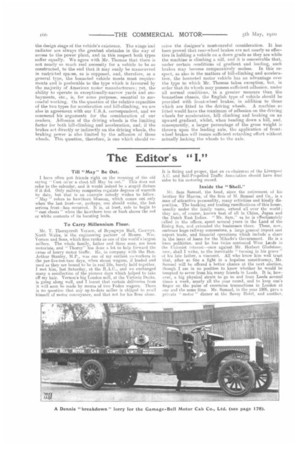Design in Relation to Adhesion.
Page 1

Page 2

If you've noticed an error in this article please click here to report it so we can fix it.
Which is. the better type of motorvan chassis—the. bonhew(' mnehine with a long wheelbase, or one with a, shorter wheelbase and having the driver mounted over the engine? the, question has frequently been raised by correspondents of this journal, and many and varying arguments in favour of one or other of the two types have been advanced by their respective advocates. A third faction asserts that the only practicable and economical position for the driver is by the side of the engine, as is the case on the Arrol-Johnston motorbuses, which are run by the Great Eastern Motor Omnibus Co., Ltd., and on the three-ton and four-ton chassis which are built by Jame and Browne, Ltd., of Hammersmith. The subject is again brought up, this time by Mr. H. Kerr Thomas, who, in his notes from the U.S.A. (page 172) clearly shows his objections to the American practice of perching the driver over the engine. American builders, however, are not alone in their present inclination towards that form of construction ; many French manufacturers also make vehicles of that type, and, in this country, the bonnetless machine finds favour with a few makers, amongst whom is Clayton and Co., Ltd., of Huddersfield, whose " Karrier-Car " vehicles continue to perform excellent work on the hilly roads in the -West Riding if Yorkshire. The Wolseley Co., too, has built machines of that type, and a number of its motorbuses, on cc hic,11 vehicles the drivers ieetipy elevated positions, is now in the service of the L.C.O.C. For special purposes, such as municipal tipping-carts, Leyland Motors, Ltd., has Also constructed chassis on the same lines, and, from the !Alit of view of accessibility, we cannot see that the engine (nt such a machine is placed at a disadvantage as compared with that on a bonneted car, provided, of course, that the question of accessibility has been kept in mind during
the design stage of the vehicle's existence. The wings land radiator are always the greatest obstacles in the way of access to the power plant, and in this respect both types suffer equally. We agree with Mr. Thomas that there is not nearly so much real necessity for a vehicle to be so constructed, to the end that it may easily be manatuvred in restricted spares, as is supposed, and, therefore, as a general type, the bonneted vehicle meets most requirements and is preferable to the type which is favoured by the majority of American motor manufacturers; yet, the ability to operate in exceptionally-narrnw yards and embayments, etc., is, for some purposes, essential to sueces,sful working. On the question of the relative capacities of the two types for acceleration and hill-climbing, we are also in agreement with our U.S.A. correspondent, and we commend his arguments for the consideration of our readers. Adhesion of the driving wheels is the limiting factor for both hill-climbing and acceleration, and, if the brakes act directly or indirectly on the driving wheels, the braking power is also limited by the adhesion of those wheels. This question, therefore, is one which should re
ceive the designer's most-careful consideration. It has been proved that rear-wheel brakes are not nearly so effece five in holding a vehicle on a down grade as they are while the machine is climbing a iiill, and it is conceivable that, under certain conditions of gradient and loading, such brakes may become comparatively useless. In this respect, as also in the matters of hill-climbing and acceleration, the bonneted motor vehicle has an advantage over the type to which Mr. Thomas takes exception, hut, in order that its wheels may possess sufficient adhesion, under all normal conditions, in a greater measure than the bonnetless chassis, the English type of vehicle should be provided with front-wheel brakes, in addition to those. which are fitted to the driving wheels. A machine so fitted would have the maximum of adhesion on the driving wheels for acceleration, hill climbing and braking on an upward gradient, whilst, when heading down a hill, and, consequently, a larger percentage of the gross weight is thrown upon the leading axle, the application of frontwheel brakes will insure sufficient retarding effort without actually locking the wheels to the axle.


























